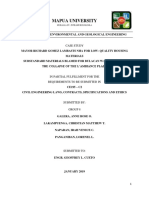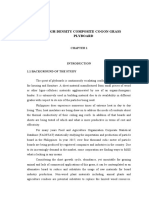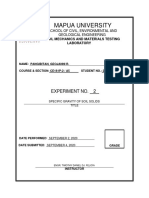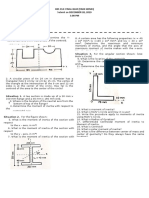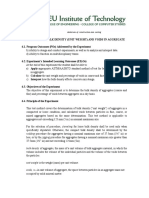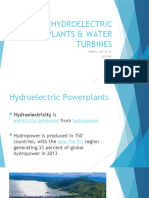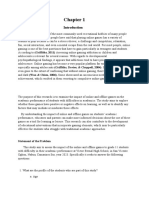Professional Documents
Culture Documents
Experiment# 11
Experiment# 11
Uploaded by
John MarkOriginal Description:
Original Title
Copyright
Available Formats
Share this document
Did you find this document useful?
Is this content inappropriate?
Report this DocumentCopyright:
Available Formats
Experiment# 11
Experiment# 11
Uploaded by
John MarkCopyright:
Available Formats
DEPARTMENT OF CIVIL ENGINEERING
Materials of Construction and Testing
EXPERIMENT 11: TIME OF SETTING OF HYDRAULIC CEMENT BY VICAT
NEEDLE
11.1. Program Outcomes (POs) Addressed by the Experiment
b) Ability to design and conduct experiments, as well as to analyze and interpret data.
d) Ability to function on multidisciplinary teams.
11.2. Experiment’s Intended Learning Outcomes (EILOs)
At the end of this experiment the student shall be able to:
a) Apply appropriate ASTM/AASHTO standards for time of setting of hydraulic cement.
b) Examine the effect of water in the setting time of hydraulic cement.
c) Prepare the necessary amount of water to combine with hydraulic cement to control
concrete mixtures and design.
11.3. Objectives of the Experiment
The objective of this experiment is to determine the time setting of hydraulic cement by
means of vicat needle.
11.4. Principle of the Experiment
This test method provides a means of determining compliance with a specification limit for Vicat
time of setting.
The measured time of setting is affected by the percentage and temperature of the water used, the
amount of kneading the paste received, and by the temperature and humidity of the mixing room
air and the moist cabinet or moist room air.
The measured time of setting of hydraulic cement is test-method specific. Time of setting as
measured by this method will not necessarily be similar to other methods used for determining
the time of setting of hydraulic cements.
.
11.5. Materials / Equipment
Weights / Weighing Device
Glass Graduates
Vicat Apparatus
Container
Scoop / Spatula
Labelling Devices
11.6. Procedure
11.6.1. Preparation of Cement Paste
1. Weigh 650 grams of cement with the percentage of mixing water required for
normal consistency. Distilled water is preferable and shall be used for all the
referee or cooperative tests.
2. The test specimen used for the determination of normal consistency may be used
for the additional determination of setting time by Vicat needle.
11.6.2. Molding Test Specimen
1. Quickly form the cement paste, prepared as described in Preparation of Cement
Paste, into a ball with the gloved hands and toss six times from one hand to the
other, maintaining the hands about 6in (152mm) apart.
Wednesday, October 21, 2020 2
2. Press the ball, resting in the palm of the hand, into the larger end of the conical
ring held in the other hand, completely filling the ring with paste.
3. Remove the excess at the larger end by a single movement of the palm of the
hand. Place the ring on its larger end on a glass plate and slice off the excess
paste at the smaller end at the top of the ring by a single oblique, stroke of a
sharp – edged trowel held at a slight angle with the top of the ring.
4. Smooth the top of the specimen, if necessary, with one or two light touches of the
pointed end of the trowel. During the operation of cutting and smoothing, take
care not to compress the paste.
5. Immediately after molding, place the test specimen in the moist closet or moist
room and allow it to remain there except when determinations of time setting are
being made. The specimen shall remain in the conical mold, supported by the
glass plate throughout the test period. A time of set specimen and an autoclave
bar may be made from the same batch.
Wednesday, October 21, 2020 3
11.6.3. Time of Setting Determination
Allow the time of setting specimen to remain in the moist cabinet for 30 minutes after
molding without being disturbed. Determine the penetration of the 1mm needle at
this time and every 15 minutes thereafter until a penetration of 25mm or less is
obtained.
1. For the penetration test, lower the needle of the rod until it rest on the surface of
the cement paste.
2. Tighten the screw and set the indicator at the upper end of the scale or take an
initial reading.
Wednesday, October 21, 2020 4
3. Release the rod quickly by releasing the set screw and allow the needle to settle
for 30 seconds; then take the reading to determine the penetration. If the paste is
obviously quite soft on the early readings, the fall of the rod may be retarded to
avoid bending the 1-mm needle, but the rod shall be released only by the set
screw when actual determinations for the setting time are made. No penetration
test shall be made closer than ¼ inch (6.4mm) from any previous penetration and
no penetration test shall be made closer than 3/8 inch (9.5mm) from the inside of
the mold.
4. Record the results of all penetration tests and, by interpolation, determine the
time when a penetration of 25mm is obtained. This is the initial setting time. The
final setting time is when the needle does not sin visibly into the paste,
Wednesday, October 21, 2020 5
Note:
All apparatus shall be free from vibration during the penetration test. Take care
to keep the 1mm needle straight, and the needle must be kept clean as the
collection of cement on the sides of the needle may retard the penetration, while
cement on the point may increase the penetration. The time of setting is affected
not only by the percentage and the temperature of the water used and the amount
of kneading the paste received, but also by the temperature and humidity of the
air, and its determination is therefore only approximate.
11.7. Activity Report
Course: BSCE Experiment No.: 11
Group No.: 1 Section: V134A
Group Members: AGUILAR, RICO RHEN Date Performed:
AZORES, TRISTAN JANUS Date Submitted:
BALDO, MICHEAL Instructor: ENGR. ALMIENDA
BARCELO, IAN FREDRICK
CAGURUNGAN, JOHN MARK
11.7.1. Data and Results
TIME PENETRATION
TRIAL
(minutes) (mm)
1 15 40
2 30 40
3 45 40
4 60 40
5 75 39
Wednesday, October 21, 2020 6
6 90 39
7 105 35
8 120 31
9 135 26
10 150 22
11 165 22
11.7.2. Calculation
Initial Setting Time _150 minutes_
Final Setting Time _165 minutes_
11.7.3. Observation
Aguilar, Rico Rhen
This test method is used to determine the time of setting of the hydraulic cement by
VICAT needle apparatus. The knowledge of the setting time of the cement is always
helpful in deciding the time duration to mix, transport, place and compact the concrete
effectively. We always prefer a larger initial setting time so that we can mix, transport
and place the concrete easily. According to ASTM specifications, the initial setting time
shall not be less than 45 min but in the field we prefer an initial setting time not less than
90 min.
Azores, tristan janus
Baldo, Micheal
Barcelo, ian fredrick
Cagurungan, John Mark
In this experiment i observed to determine the range of applicability of the method from
the range of the average time of setting of the cements used for qualification and
standardization. Also i observed that you need to be more patient to determine the exact
time.
Wednesday, October 21, 2020 7
11.7.4. Conclusion/s
Aguilar, Rico Rhen
Based on our experiment, a smaller value of the final setting time is always preferred in
order to avoid large expenditures on the formwork. According to our experiment, the
final setting time shall not be greater than 3hrs and shall not be less than 90 minutes with
15 minutes interval. The first to fourth trial, we come up with consistent penetration with
40 mm but the following trials the cement is starting to become concrete. With that, we
conclude that the gathered data with initial setting time is 150 minutes while the final
setting time with 165 minutes.
Azores, tristan janus
Baldo, Micheal
Barcelo, ian fredrick
Cagurungan, John Mark
I conclude that in this test method provides a means of determining compliance with a
specification limit for Vicat time of setting. Refer to the appropriate specification for the
cement to determine if this test method is used for specification compliance. Also i
conclude in experiment the final setting time shall not be less than 90 minutes and greater
than 180 minutes or 3hrs. The 1st to 4th trial the consistency of cement is 40mm no
change, after 10 to 11 trial our cement was consistent in 22, (time is 150 and 160
minutes). After that it ready for the next test.
11.7.5. Rating
11.8. References
ASTM C191. (2004). Standard Method of Test for Time Setting of Hydraulic Cement by Vicat
Needle. West Conshohocken, PA: ASTM International.
Wednesday, October 21, 2020 8
Bureau of Research and Standards. (2014). Laboratory Testing Procedures Manual: Portland
Cement (Vol. III). Department of Public Works and Highways.
Wednesday, October 21, 2020 9
You might also like
- Multistate Pharmacy Jurisprudence Examination (MPJE) Study GuideDocument20 pagesMultistate Pharmacy Jurisprudence Examination (MPJE) Study GuideMcRee Learning Center100% (2)
- Module 1 Conmatls Chapter 4Document10 pagesModule 1 Conmatls Chapter 4CARL JAMESNo ratings yet
- Technological Institute of The Philippines Aurora Boulevard, Cubao, Quezon CityDocument7 pagesTechnological Institute of The Philippines Aurora Boulevard, Cubao, Quezon CityRyan David MacayanNo ratings yet
- Laboratory Experiment No. 2 Horizontal Measurements 1. Objective: 2. Intended Learning Outcomes (Ilos)Document4 pagesLaboratory Experiment No. 2 Horizontal Measurements 1. Objective: 2. Intended Learning Outcomes (Ilos)Gav MonzonNo ratings yet
- Module - 4 6 - Ge Ce 1Document42 pagesModule - 4 6 - Ge Ce 1Hades Vesarius RiegoNo ratings yet
- Reaction Paper To The Importance of Soil Mechanics To The Field of Civil EngineeringDocument1 pageReaction Paper To The Importance of Soil Mechanics To The Field of Civil Engineeringjeany noquilloNo ratings yet
- Laying Out Simple Curve With An ObstructionDocument5 pagesLaying Out Simple Curve With An ObstructionEljenColanggoNo ratings yet
- Juan Miguel Banzon 2018140404 ESE150-2/B1 Reflection Paper 1 - Lion King Desert EcosystemDocument5 pagesJuan Miguel Banzon 2018140404 ESE150-2/B1 Reflection Paper 1 - Lion King Desert EcosystemTWICE TEUDOONGIE0% (1)
- 002 Design Base Shear PDFDocument34 pages002 Design Base Shear PDFJohn Mark100% (2)
- Aow t2 2 Myths and Legends Poseidon The Greek God of The SeaDocument4 pagesAow t2 2 Myths and Legends Poseidon The Greek God of The Seaapi-233129203No ratings yet
- Opcodes Packets ReversingDocument3 pagesOpcodes Packets ReversingMarius UngureanuNo ratings yet
- Mapua University: Case StudyDocument39 pagesMapua University: Case StudySkyler PamatmatNo ratings yet
- Research On Soil StabilizationDocument6 pagesResearch On Soil StabilizationDeity ReuterezNo ratings yet
- Esci 121 - Fundamentals of SurveyingDocument7 pagesEsci 121 - Fundamentals of Surveyinghen henNo ratings yet
- Classification of Engineering ServicesDocument7 pagesClassification of Engineering ServicesChuckMañoscaNo ratings yet
- CE405 - Experiment 2 - Sieve AnalysisDocument4 pagesCE405 - Experiment 2 - Sieve AnalysisMel CoderesNo ratings yet
- Describe Some Surveying Applications In: (A) Construction (B) Mining (C) AgricultureDocument3 pagesDescribe Some Surveying Applications In: (A) Construction (B) Mining (C) AgricultureAllyssa Jane B. OrejudosNo ratings yet
- Dynamic Property of Rocks: Types of Wave TheoryDocument11 pagesDynamic Property of Rocks: Types of Wave TheoryCHRISTIAN NATHANIEL PALMA100% (1)
- ConclusionDocument5 pagesConclusionkhairulhakam50% (2)
- Experiment 2: Normal Consistency of Cement: Results and AnalysisDocument2 pagesExperiment 2: Normal Consistency of Cement: Results and AnalysisCyrille's ThoughtsNo ratings yet
- Lab06rotating VesselDocument3 pagesLab06rotating VesselJQNo ratings yet
- ch02 2Document4 pagesch02 2yi LeeNo ratings yet
- Construction Materials and Testing: Group 2 - Bsce 2L C12Document17 pagesConstruction Materials and Testing: Group 2 - Bsce 2L C12Nathalie AsiloNo ratings yet
- Slump Test of Fresh Concrete (ASTM C143/C143M-05a) & (BS 1881: PART 102:83)Document17 pagesSlump Test of Fresh Concrete (ASTM C143/C143M-05a) & (BS 1881: PART 102:83)Zahim Harki100% (1)
- E3Document4 pagesE3royNo ratings yet
- Differentiate Error and Mistakes in SurveyingDocument2 pagesDifferentiate Error and Mistakes in SurveyingHerjay Racho SulapasNo ratings yet
- GEOLOGYDocument8 pagesGEOLOGYbihonmiki061No ratings yet
- Experiment 7: Tension Test of Steel: School of Civil, Environmental, and Geological EngineeringDocument7 pagesExperiment 7: Tension Test of Steel: School of Civil, Environmental, and Geological EngineeringJoash SalamancaNo ratings yet
- SURVEYING Lec2 19 20Document13 pagesSURVEYING Lec2 19 20brandonNo ratings yet
- Filipino EngineersDocument7 pagesFilipino EngineersJulius Mananghaya0% (1)
- CMT Lab Work 006-1Document4 pagesCMT Lab Work 006-1Rj WandaganNo ratings yet
- ECE Review-Progression and Binomial TheoremDocument2 pagesECE Review-Progression and Binomial TheoremRAY100% (1)
- Historical Background and Early Fathers On Structural EngineeringDocument7 pagesHistorical Background and Early Fathers On Structural EngineeringArteezy BabaevNo ratings yet
- Fieldwork No. 5 Laying of A Reverse Curve Using Transit and TapeDocument11 pagesFieldwork No. 5 Laying of A Reverse Curve Using Transit and TapeReinald Gabriel ApostolNo ratings yet
- ACTIVITY 3 - Preparation of Undisturbed Soil Sample For TestingDocument5 pagesACTIVITY 3 - Preparation of Undisturbed Soil Sample For TestingNiko ChavezNo ratings yet
- Learning Activity in Lesson 3Document5 pagesLearning Activity in Lesson 3Carl Stephen Martinez TiongsonNo ratings yet
- Fieldwork No. 5 Laying of A Reverse Curve Using Transit and TapeDocument5 pagesFieldwork No. 5 Laying of A Reverse Curve Using Transit and TapeJeff CruzNo ratings yet
- De CASTRO, JEAN C. - Lab Report No.5 - Fineness of CementDocument11 pagesDe CASTRO, JEAN C. - Lab Report No.5 - Fineness of CementJean De CastroNo ratings yet
- QB18 PDFDocument10 pagesQB18 PDFRaNo ratings yet
- Lab Ex5 Inclined Stadia SightsDocument5 pagesLab Ex5 Inclined Stadia SightsJuan Gilio SuarezNo ratings yet
- Equipment and Apparatus For Testing: Cement 1. Blaine Air ApparatusDocument11 pagesEquipment and Apparatus For Testing: Cement 1. Blaine Air ApparatusGabriel VergaraNo ratings yet
- Orca Share Media1563893935881Document6 pagesOrca Share Media1563893935881Loki PagcorNo ratings yet
- Vernier and Micrometer Activity SheetDocument5 pagesVernier and Micrometer Activity SheetJoseph Tabulina0% (1)
- Setting Time of CementDocument3 pagesSetting Time of CementKhairunnisa ZakiriNo ratings yet
- Borehole Shear Test: Ce 641 - Site Investigation PracticeDocument20 pagesBorehole Shear Test: Ce 641 - Site Investigation PracticesatheekNo ratings yet
- Lab Report No. 7 Plastic and Liquid Limit of SoilDocument52 pagesLab Report No. 7 Plastic and Liquid Limit of Soilkim suarezNo ratings yet
- Me136p Exp5 Sieve Analysis of AggregatesDocument9 pagesMe136p Exp5 Sieve Analysis of AggregatesJohn Henry SalvadoNo ratings yet
- Ce Laws The Seven Canons of Ethics With Assessment CtuDocument19 pagesCe Laws The Seven Canons of Ethics With Assessment CtuCharlie OnlyNo ratings yet
- Study Guide For Module 1 PDCSDocument10 pagesStudy Guide For Module 1 PDCSKherstine Muyano TantayNo ratings yet
- Experiment 1 CompleteDocument7 pagesExperiment 1 CompleteRenNo ratings yet
- Construction Innovation in The PhilippinesDocument8 pagesConstruction Innovation in The PhilippinesJelai YumulNo ratings yet
- High-Density Composite Cogon Grass PlyboardDocument10 pagesHigh-Density Composite Cogon Grass Plyboard?No ratings yet
- Mapua University: Experiment No. 2Document12 pagesMapua University: Experiment No. 2Geojanni PangibitanNo ratings yet
- Lab 10: Modified ProctorDocument20 pagesLab 10: Modified Proctorkim suarezNo ratings yet
- Lecture 2 (Kinematics of Particles, Uniform Rectilinear Motion - Uniformly Accelerated Rectilinear Motion)Document26 pagesLecture 2 (Kinematics of Particles, Uniform Rectilinear Motion - Uniformly Accelerated Rectilinear Motion)Robby RebolledoNo ratings yet
- Experiment No. 6: Surface Moisture of Fine and Coarse Aggregate DiscussionDocument6 pagesExperiment No. 6: Surface Moisture of Fine and Coarse Aggregate DiscussionRochelleNo ratings yet
- Lab No. 5 - Determination of Unit Weight, Dry Weight, Void Ratio, and PorosityDocument7 pagesLab No. 5 - Determination of Unit Weight, Dry Weight, Void Ratio, and PorosityBEA MAE OTERONo ratings yet
- Submit On DECEMBER 20, 2019: Bes 314: Final Quiz (Take Home) 1:00 PMDocument2 pagesSubmit On DECEMBER 20, 2019: Bes 314: Final Quiz (Take Home) 1:00 PMahmad ryan0% (1)
- CENGR-4120: Flood Control and Drainage DesignDocument4 pagesCENGR-4120: Flood Control and Drainage DesignLORNA BACLIGNo ratings yet
- Internal Resistance AppliedDocument11 pagesInternal Resistance AppliedJoshua BacunawaNo ratings yet
- CMT Laboratory 5 Determination of Surface Moisture of Coarse AggregatesDocument6 pagesCMT Laboratory 5 Determination of Surface Moisture of Coarse AggregatesBryanHarold BrooNo ratings yet
- Experiment # 12Document8 pagesExperiment # 12John MarkNo ratings yet
- Engineering Materials Exp. - 2Document6 pagesEngineering Materials Exp. - 2Nahid SultanNo ratings yet
- Module 3 Conmatls Chapter 12Document5 pagesModule 3 Conmatls Chapter 12Kriselle DulayNo ratings yet
- Department of Civil Engineering: Materials of Construction and TestingDocument5 pagesDepartment of Civil Engineering: Materials of Construction and TestingJohn MarkNo ratings yet
- Expi. 2 GroupreportDocument2 pagesExpi. 2 GroupreportJohn MarkNo ratings yet
- Experiment 6: Bulk Density (Unit Weight) and Voids in Aggregate 6.1. Program Outcomes (Pos) Addressed by The ExperimentDocument5 pagesExperiment 6: Bulk Density (Unit Weight) and Voids in Aggregate 6.1. Program Outcomes (Pos) Addressed by The ExperimentJohn MarkNo ratings yet
- Expi. 5 GroupreportDocument3 pagesExpi. 5 GroupreportJohn MarkNo ratings yet
- Experiment # 14Document7 pagesExperiment # 14John MarkNo ratings yet
- Hydroelectric Powerplants & Water TurbinesDocument9 pagesHydroelectric Powerplants & Water TurbinesJohn MarkNo ratings yet
- Penetration Is Defined As The Consistency of A Bituminous Material Expressed As The DistanceDocument7 pagesPenetration Is Defined As The Consistency of A Bituminous Material Expressed As The DistanceJohn MarkNo ratings yet
- 14 Making and Curing Concrete Test Specimens in The FieldDocument6 pages14 Making and Curing Concrete Test Specimens in The FieldJohn MarkNo ratings yet
- Watershed Management: Pantabangan DamDocument14 pagesWatershed Management: Pantabangan DamJohn Mark0% (1)
- Deventer04 MACDocument201 pagesDeventer04 MACFrancisco Solano Reyes EspinozaNo ratings yet
- EFA Writing Position PaperDocument55 pagesEFA Writing Position PaperPhoebe AdolfoNo ratings yet
- E-Notes by K. Udaya Kumar, BNMIT, Bangalore: 8086 Addressing Modes For Accessing DataDocument68 pagesE-Notes by K. Udaya Kumar, BNMIT, Bangalore: 8086 Addressing Modes For Accessing DataPavitra Bai SNo ratings yet
- Tax Guidelines For E-Commerce Transactions in The PhilippinesDocument44 pagesTax Guidelines For E-Commerce Transactions in The PhilippinesJanette ToralNo ratings yet
- Avadh Law College: LL.B. Eighth SemesterDocument10 pagesAvadh Law College: LL.B. Eighth SemesterDesi BoyNo ratings yet
- 8 Material Self 1Document17 pages8 Material Self 1marbie aliyahNo ratings yet
- Lecture Notes To Neural Networks in Electrical EngineeringDocument11 pagesLecture Notes To Neural Networks in Electrical EngineeringNaeem Ali SajadNo ratings yet
- Health Insurance Ebook PDFDocument29 pagesHealth Insurance Ebook PDFIvan Grgić100% (1)
- Reflective ReportDocument3 pagesReflective ReportGiorgos BadouvakisNo ratings yet
- Lecture 30 - Histology of Special Sensory Organs - EyeDocument53 pagesLecture 30 - Histology of Special Sensory Organs - Eyespitzmark2030No ratings yet
- Magnetocaloric Effect A Review of The Thermodynamic CyclesDocument9 pagesMagnetocaloric Effect A Review of The Thermodynamic CyclesYangyangNo ratings yet
- Drager Medical Et. Al. v. Allied Healthcare ProductsDocument9 pagesDrager Medical Et. Al. v. Allied Healthcare ProductsPriorSmartNo ratings yet
- Finance: What Is Finance? MeaningDocument4 pagesFinance: What Is Finance? MeaningnadiaabrarNo ratings yet
- FCEfSST.3 P3 AUDIOSCRIPTDocument3 pagesFCEfSST.3 P3 AUDIOSCRIPTMario AlbenizNo ratings yet
- Nature and The CityDocument3 pagesNature and The CityZaid PerdanaNo ratings yet
- Economic Choice Modeling SummaryDocument56 pagesEconomic Choice Modeling SummarySidra MuddasarNo ratings yet
- Oblicon LawDocument5 pagesOblicon LawJulie Neay AfableNo ratings yet
- Online and Offline GamesDocument8 pagesOnline and Offline GamesChristine JoyNo ratings yet
- Empowerment Technologies: Performance Task 4: Regional Science High School For Region IDocument3 pagesEmpowerment Technologies: Performance Task 4: Regional Science High School For Region IAngelica MaganisNo ratings yet
- COI - 92000103114 - Harsh VasoyaDocument27 pagesCOI - 92000103114 - Harsh VasoyaParth SabhayaNo ratings yet
- Marketing QuestionnaireDocument10 pagesMarketing QuestionnaireeliasNo ratings yet
- George SegalDocument13 pagesGeorge SegaljaimecreamNo ratings yet
- Hand Book Doda 2012-13Document250 pagesHand Book Doda 2012-13DevinderKumarNo ratings yet
- 31725H Unit6 Pef 20190814Document25 pages31725H Unit6 Pef 20190814hello1737828No ratings yet
- (IN) VISIBLE by Oliver TappeDocument166 pages(IN) VISIBLE by Oliver TappeChuga StanNo ratings yet
- Akij Group of CompanyDocument11 pagesAkij Group of CompanyRussell Ahmed Dider0% (3)
- Francis TurbineDocument56 pagesFrancis TurbineAkshat JainNo ratings yet











